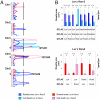Incremental steps toward incompatibility revealed by Arabidopsis epistatic interactions modulating salicylic acid pathway activation
- PMID: 19106299
- PMCID: PMC2629243
- DOI: 10.1073/pnas.0811734106
Incremental steps toward incompatibility revealed by Arabidopsis epistatic interactions modulating salicylic acid pathway activation
Abstract
Plant growth is influenced by genetic factors and environmental cues. Genotype-by-environment interactions are governed by complex genetic epistatic networks that are subject to natural selection. Here we describe a novel epistatic interaction modulating growth in response to temperature common to 2 Arabidopsis recombinant inbred line (RIL) populations (Ler x Kas-2 and Ler x Kond). At 14 degrees C, lines with specific allele combinations at interacting loci (incompatible interactions) have severe growth defects. These lines exhibit deregulated cell death programs and enhanced disease resistance. At 20 degrees C, growth defects are suppressed, but a positive trait of enhanced resistance is retained. Mapping of 1 interacting QTL to a cluster of RPP1-like TIR-NB-LRR genes on chromosome 3 is consistent with our finding that environmentally conditioned epistasis depends on activation of the salicylic acid (SA) stress signaling pathway. The nature of the epistatic interaction conforms to the Dobzhansky-Muller model of genetic incompatibility with incomplete penetrance for reproductive isolation. Variation in fitness of different incompatible lines reveals the presence of additional modifiers in the genetic background. We propose that certain interacting loci lead to an optimal balance between growth and resistance to pathogens by modulating SA signaling under specific environments. This could allow the accumulation of additional incompatibilities before reaching complete reproductive isolation.
Conflict of interest statement
The authors declare no conflict of interest.
Figures





References
-
- Mitchell-Olds T, Schmitt J. Genetic mechanisms and evolutionary significance of natural variation in Arabidopsis. Nature. 2006;441:947–952. - PubMed
-
- Abbott RJ, Gomes MF. Population genetic structure and outcrossing rate of Arabidopsis thaliana (L. ) Heynh. Heredity. 1989;62:411–418.
-
- Tonsor S, Alonso-Blanco C, Koornneef M. Gene function beyond the single trait: Natural variation, gene effects, and evolutionary ecology in Arabidopsis thaliana. Plant Cell Environ. 2005;28:2–20.
-
- Weinreich DM, Watson RA, Chao L. Perspective: Sign epistasis and genetic constraint on evolutionary trajectories. Evolution. 2005;59:1165–1174. - PubMed
-
- Dobzhansky T. Genetics and the Origin of Species. New York: Columbia Univ Press; 1937.
Publication types
MeSH terms
Substances
Associated data
- Actions
LinkOut - more resources
Full Text Sources
Other Literature Sources

